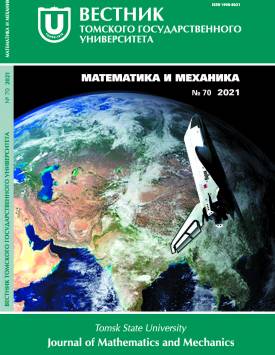Numerical simulation of a power-law fluid flow in a channel with double constriction
Flow fields of non-Newtonian fluids in cylindrical channels with obstacles are of great interest for researchers studying the mechanics of fluids. In engineering techniques, such channels represent component parts of heat exchangers and hydraulic systems of various types. In this work, the numerical simulation of a steady non-Newtonian fluid flow in an axisymmetric pipe with two overlaps, whose geometry is described by a cosine function, is carried out. Mathematical formulation of the problem is written in terms of vortex and stream function variables. The Ostwald - de Waele model is used to describe rheological properties of the medium. The solution to a system of differential equations is obtained numerically using the false transient method. To determine the pressure field, the Poisson equation for pressure is solved. Three media are considered in the paper: Newtonian, pseudoplastic, and dilatant fluids. The influence of the Reynolds number, power-law index in the rheological model, and geometric parameters of the channel on the flow characteristics is shown as streamline distributions and functional curves.
Keywords
laminar flow,
double constriction,
power-law fluid,
Ostwald-de Waele model,
coordinate transformation,
pressure Poisson equationAuthors
| Ryltsev Ivan A. | Tomsk State University | ryltsev_i@ftf.tsu.ru |
| Frolov Oleg Yu. | Tomsk State University | frolovoy@mail.tsu.ru |
| Shrager Gennady R. | Tomsk State University | shg@ftf.tsu.ru |
Всего: 3
References
Forrester J.H., Young D.F. Flow through a converging-diverging tube and its implications in occlusive vascular disease - I. Theoretical development // Journal of Biomechanics. 1970. V. 3. Iss. 3. P. 297-305.
Lee J.S., Fung Y.C. Flow in locally constricted tubes at low Reynolds numbers // Journal of Applied Mechanics. 1970. V. 37. Iss. 1. P. 9-16.
Young D.F., Tsai F.Y. Flow characteristics in model of arterial stenoses-I. Steady flow // Journal of Biomechanics. 1973. V. 6. Iss. 4. P. 395-402.
Deshpande M.D., Giddens D.P., Mabon R.F. Steady laminar flow through modelled vascular stenosis // Journal of Biomechanics. 1976. V. 9. Iss. 4. P. 13-20.
MacDonald D.A. On steady flow through modelled vascular stenosis // Journal of Biomechanics. 1979. V. 12. Iss. 1. P. 165-174.
Liepsch D., Singh M., Lee M. Experimental analysis of the influence of stenotic geometry on steady flow // Biorheology. 1992. V. 29. Iss. 4. P. 419-431.
Shukla J.B., Parihar R.S., Rao B.R. Effects of stenosis on non-newtonian flow of the blood in an artery // Bulletin of Mathematical Biology. 1980. V. 42. Iss. 3. P. 283-294.
Manimaran R. CFD simulation of non-Newtonian fluid flow in arterial stenoses with surface irregularities // World Academy of Science, Engineering and Technology. 2011. V. 73. P. 957-962.
Leuprecht A., Perktold K. Computer simulation of non-newtonian effects on blood flow in large arteries // Computer Methods in Biomechanics and Biomedical Engineering. 2001. V. 4. Iss. 2. P. 149-163.
Jahangiri M., Saghafian M., Sadeghi M.R. Numerical simulation of non-Newtonian models effect on hemodynamic factors of pulsatile blood flow in elastic stenosed artery // Journal of Mechanical Science and Technology. 2017. V. 31. Iss. 2. P. 1003-1013.
Tu C. , Deville M. Pulsatile flow of non-Newtonian fluids through arterial stenosis // Journal of Biomechanics. 1996. V. 29. Iss. 7. P. 899-908.
Prakash O., Makinde O.D., Singh S.P., Jain N., Kumar D. Effects of stenoses on nonNewtonian flow of blood in blood vessels // International Journal of Biomathematics. 2015. V. 8 Iss. 1. P. 1550010-1-1550010-13.
Рыльцев И.А., Рыльцева К.Е., Шрагер Г.Р. Кинематика течения степенной жидкости в трубе переменного сечения // Вестник Томского государственного университета. Математика и механика. 2020. № 63. C. 125-138.
Lee T.S. Numerical studies of fluid flow through tubes with double constrictions // International Journal for Numerical Methods in Fluids. 1990. V. 11. Iss. 8. P. 1113-1126.
Lee T.S. Steady laminar fluid flow through variable constrictions in vascular tubes // Journal of Fluids Engineering, Transactions of the ASME. 1994. V. 116. Iss. 1. P. 66-71.
Lee T.S., Liao W., Low H.T. Numerical simulation of turbulent flow through series stenosis // International Journal for Numerical Methods in Fluids. 2003. V. 42. Iss. 7. P. 717-740.
Huang H., Lee T.S., Shu C. Lattice-BGK simulation of steady flow through vascular tubes with double constrictions // International Journal of Numerical Methods for Heat and Fluid Flow. 2006. V. 16. Iss. 2. P. 185-203.
Роуч П. Вычислительная гидродинамика. М.: Мир, 1980. 616 с.
Ostwald W. Ueber die rechnerische Darstellung des Strukturgebietes der Viskositat // Kolloid Zeitschrift. 1929. V. 47. Iss. 2. P. 176-187.
Годунов С.К., Рябенький В.С. Введение в теорию разностных схем. М.: Физматгиз, 1962. 340 c.

